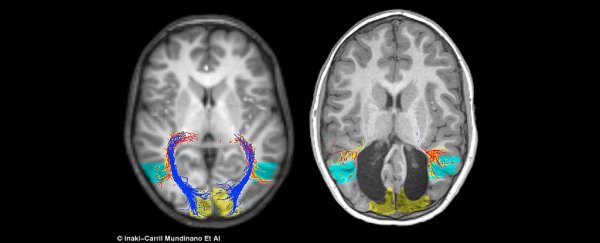A seven-year-old Australian boy who is missing most of his visual cortex has surprised doctors by being able to see well enough to recognise faces and play soccer - the first known case of its kind.
In spite of suffering a significant brain injury when he was a newborn, the biggest problem the boy, referred to only as "B.I.", has with his vision is he's a little near-sighted, showing once again just how amazingly flexible our grey matter is.
Speaking at a neuroscience conference in Sydney this week, researchers from the Australian Regenerative Medicine Institute at Monash University presented B.I.'s case study - when he was just two weeks of age, he suffered a bilateral occipital-lobe injury.
In other words, major damage to his visual cortex.
The visual cortex is a region of the wrinkled, outer part of the brain at the back of your head responsible for sorting information from the retina into a personal picture show.
To be more precise, the retina sends messages down the optic nerve to a relay centre in the thalamus called the inferior pulvinar, which helps control and focus the eyes based on the objects in the line of sight.
From there the information goes to a part of the visual cortex called visual area 1 (V1). That's where the magic happens.
Unfortunately for B.I., as an infant he suffered medium-chain acyl-Co-A dehydrogenase (MCAD) deficiency, a condition that prevents tissues from converting certain fats into energy.
The results left him with a lesion in his V1, which should have at least interfered with the process of converting retinal information into a coherent image.
Apparently not.
"Despite the extensive bilateral occipital cortical damage, B.I. has extensive conscious visual abilities, is not blind, and can use vision to navigate his environment," the researchers report.
Monash neuroscientist Iñaki-Carril Mundiñano told Alice Klein from New Scientist that nobody would suspect B.I. to be blind.
"He navigates his way around without any problems and plays soccer and video games," says Mundiñano.
Lesions to V1 have been known to leave individuals with some visual traits we don't usually give much thought to.
Known as blindsight, the condition is more or less like seeing without being conscious of any images.
It presents itself as an ability to respond to visual stimuli or 'sense' things like movement in such a way that makes it unlikely the individual is simply guessing.
The extraordinary thing about blindsight is it demonstrates our sense of vision extends far beyond what we experience consciously as pictures.
This isn't what B.I. is experience, though. Those are real images inside his mind.
"Furthermore, he can readily and consciously identify happy and neutral faces and colours, tasks associated with ventral stream processing," says Mundiñano.
Perhaps thanks to the fact the lesion formed while B.I. was still quite young, it seems as if his developing brain re-routed the information from the retina to make use of one of the visual cortex's other units.
To test this, the researchers mapped his brain's neural tracts using magnetic resonance imaging ( MRI).
They focussed largely on the highway between the inferior pulvinar and a part of the visual cortex called the middle temporal visual area (MT or V5), which helps detect movement.
Sure enough, this pathway appeared to be larger than expected in the left hemisphere, suggesting that the pulvinar 'relay station' took on more of the V1's responsibilities early in development.
Another team of neuroscientists recently reported the brain of the world's youngest double hand transplant, 10 year-old Zion Harvey, is reverting to a pattern that resembles his 'pre-amputation' cortex.
In other words, without hands, his body had made use of the old real estate. Now his newly transplanted hands are taking it back again.
We really shouldn't be surprised any more when we hear just how malleable and adaptable the human brain is.
But seriously, how amazing are brains?
